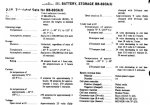- 10,350
- 94
- 48
- Location
- Meadows of Dan, Virginia
Been working on this off and on for about a year, simply tired of the problems with lead acid batteries, poor cold weather performance, trickle charging, maintainers that fail not to mention poor contact burning battery studs etc.
Yesterday I started the truck on the LA's and charged the nicads at a rate of about 10-15 amps for two hours. Figured that would be about 60-70% of a full charge for the 30 AH NiCd cells (charging current drops and it would take several more hours to complete the charge).
Today I removed the LA's and cranked the 8x8 engine with the fuel solenoid "OFF", looking for current draw, cranking rpm and voltage before starting it.
So far, the Nicads are doing the job very well, voltage dropped to about 21 VDC and the current draw was about 295 amps. I have a current shunt permanently installed as part of the transition from cell to original cable connection. The copper links seen in the image will be replaced with nickel plated bars to keep from corroding.
Very happy with results and without the lead alloy terminals, the connections can be torqued to normal bolt spec, hopefully eliminating poor connection problems.
Yesterday I started the truck on the LA's and charged the nicads at a rate of about 10-15 amps for two hours. Figured that would be about 60-70% of a full charge for the 30 AH NiCd cells (charging current drops and it would take several more hours to complete the charge).
Today I removed the LA's and cranked the 8x8 engine with the fuel solenoid "OFF", looking for current draw, cranking rpm and voltage before starting it.
So far, the Nicads are doing the job very well, voltage dropped to about 21 VDC and the current draw was about 295 amps. I have a current shunt permanently installed as part of the transition from cell to original cable connection. The copper links seen in the image will be replaced with nickel plated bars to keep from corroding.
Very happy with results and without the lead alloy terminals, the connections can be torqued to normal bolt spec, hopefully eliminating poor connection problems.
Attachments
-
84.1 KB Views: 82
-
81.3 KB Views: 75
-
86.7 KB Views: 69












